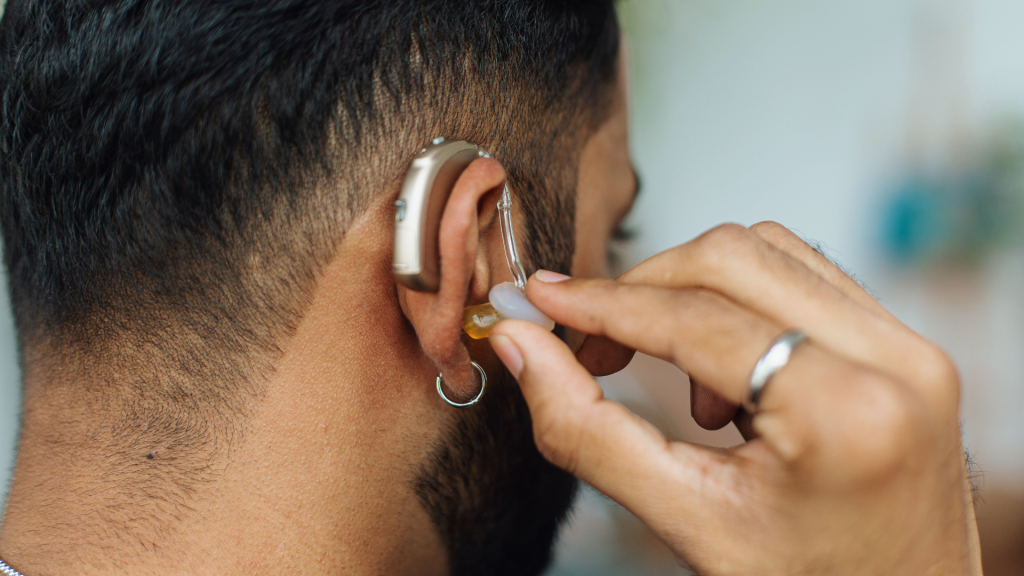Choosing a hearing aid isn’t just about picking a device—it’s about improving your quality of life. With so many options on the market today, from discreet in-ear models to high-tech, Bluetooth-enabled devices, it’s easy to feel overwhelmed. Whether you’re just beginning your hearing journey or replacing an old device, the process can raise a lot of questions: What kind of hearing aid do I need? Will it be comfortable? How much should I spend? Should I buy online or through a clinic?
The good news is that you don’t have to navigate this decision alone. This complete buyer’s guide is designed to walk you through every step—from understanding your hearing needs to choosing the right technology and getting properly fitted. We’ll cover the styles, features, and practical considerations that make all the difference when selecting the hearing aid that fits your life.
Let’s explore how to make an informed, confident choice—so you can hear better, live better, and reconnect with the sounds and people that matter most.
Understanding Your Hearing Loss: The First Step
Before choosing a hearing aid, it’s essential to understand the nature of your hearing loss. Not all hearing aids are created equal, and the right device for you depends on your specific hearing profile. That’s why the first and most critical step in this process is to get a professional hearing evaluation.
Why a Hearing Test Matters
A comprehensive hearing test, usually performed by an audiologist or hearing care specialist, measures your ability to hear different frequencies and speech in quiet and noisy environments. The results are plotted on an audiogram, which shows:
- Degree of hearing loss (mild, moderate, severe, or profound)
- Type of hearing loss (sensorineural, conductive, or mixed)
- Speech discrimination ability—how clearly you can understand words
These details are crucial in determining which hearing aids will be most effective and comfortable for you.
Types of Hearing Loss
- Sensorineural Hearing Loss: The most common type, often age-related or caused by noise exposure. Typically treated with digital hearing aids.
- Conductive Hearing Loss: Caused by issues in the outer or middle ear (e.g., fluid, wax, or infections). Sometimes treatable medically or surgically before considering a hearing aid.
- Mixed Hearing Loss: A combination of both sensorineural and conductive components.
Understanding the type and severity of your hearing loss helps ensure that the hearing aid you choose has the necessary amplification and features to support your needs.
Don’t Skip This Step
While some over-the-counter (OTC) hearing aids are available without a test, skipping a professional evaluation can lead to frustration, poor results, or even buying the wrong device altogether. A hearing test also helps rule out medical conditions that may need attention before amplification.
Knowing your hearing baseline is empowering. It’s the foundation for making informed decisions, and it puts you in a better position to compare options with confidence.
Types of Hearing Aids: Styles and Features Explained
Hearing aids come in a variety of styles, each with its own strengths and limitations. The “best” hearing aid isn’t the most expensive or high-tech one—it’s the one that suits your hearing loss, lifestyle, dexterity, and cosmetic preferences. Understanding the differences in style and features will help you find a device that feels like a natural part of your daily routine.
Common Hearing Aid Styles
Behind-the-Ear (BTE)
- Description: Sits behind the ear with a tube connecting to an ear mold or dome inside the ear canal.
- Best for: Mild to profound hearing loss
- Pros: Powerful, durable, easy to handle, larger batteries
- Cons: More visible, may interfere with glasses
Receiver-in-Canal (RIC) / Receiver-in-the-Ear (RITE)
- Description: Similar to BTE but with a smaller casing and speaker placed in the ear canal
- Best for: Mild to severe hearing loss
- Pros: Discreet, natural sound quality, comfortable
- Cons: Speaker can be prone to moisture or wax damage
In-the-Ear (ITE)
- Description: Custom-molded to fill the outer part of the ear
- Best for: Mild to severe hearing loss
- Pros: Easy to insert and remove, larger controls, good battery life
- Cons: More visible than smaller models
In-the-Canal (ITC) / Completely-in-Canal (CIC)
- Description: Custom-fit devices that sit partially or completely inside the ear canal
- Best for: Mild to moderate hearing loss
- Pros: Very discreet, preserves natural ear acoustics
- Cons: Smaller size can be hard to handle, limited space for advanced features
Invisible-in-Canal (IIC)
- Description: Deeply placed inside the canal, nearly invisible
- Best for: Mild to moderate hearing loss
- Pros: Almost undetectable
- Cons: Short battery life, no wireless features, more sensitive to wax and moisture
Key Features to Consider
- Noise Reduction: Helps filter out background noise for clearer speech understanding
- Directional Microphones: Focus on sounds in front of you, great for conversations
- Telecoil (T-coil): Enhances hearing in public spaces with hearing loops (like churches or theaters)
- Bluetooth Connectivity: Syncs with phones, TVs, and other devices for streaming audio
- Rechargeable Batteries: Eliminates the need for small, disposable batteries
- Feedback Suppression: Reduces whistling or squealing sounds
- Remote Controls / Apps: Allow volume and setting adjustments from your phone
Choosing the right style and feature set is a balancing act between your hearing needs, lifestyle preferences, dexterity, and budget. An audiologist can help you test different models to see what feels most comfortable and natural.
Key Factors to Consider When Choosing a Hearing Aid
With so many hearing aids available, narrowing down your options can feel overwhelming. Beyond style and technology, you’ll want to think about how the device fits into your everyday life. Here are the most important factors to weigh when selecting the right hearing aid for you.
1. Comfort and Fit
- Your hearing aid should feel secure but not tight.
- Behind-the-ear models may take more time to get used to, especially if you wear glasses.
- Custom in-ear models are molded to your ear, offering a personalized fit, but may be harder to adjust or clean.
Tip: Always ask for a trial period—most providers offer 30–60 days for you to test comfort in real-world conditions.
2. Ease of Use
- Can you handle small batteries or controls? If not, look for larger models or rechargeable options.
- Some devices have automatic volume adjustments and pre-set programs, reducing the need for manual changes.
- Mobile app controls are great for tech-savvy users but might be frustrating for others.
3. Visibility and Discretion
- If aesthetics matter to you, smaller models (like CIC or IIC) are the most discreet.
- However, the smaller the hearing aid, the fewer features and the shorter the battery life.
- Open-fit and RIC models offer a good balance between appearance and performance.
4. Battery Type
- Disposable batteries: Require regular changing (every 3–10 days depending on size).
- Rechargeable batteries: Convenient and environmentally friendly, typically last all day on a single charge.
Tip: Consider your lifestyle—rechargeables are ideal if you travel often or dislike dealing with tiny batteries.
5. Connectivity and Smart Features
- Do you want to stream music or phone calls through your hearing aids?
- Are you interested in remote adjustments or telehealth support?
- Bluetooth-enabled devices offer powerful flexibility, but they may cost more.
6. Cost and Insurance Coverage
- Prices range from $1,000 to $7,000+ per pair depending on features, brand, and service package.
- Medicare does not typically cover hearing aids, but some private insurance or supplemental plans may offer partial coverage.
- Over-the-counter (OTC) devices are more affordable but limited to mild-to-moderate hearing loss.
7. Warranty and Service
- Ask about the warranty length, what it covers (e.g., repairs, loss), and whether follow-up care is included.
- Ongoing maintenance and adjustments are essential for long-term success.
Choosing a hearing aid is a personal decision that requires reflection on how you live, communicate, and want to hear the world. By considering these factors and discussing them with a hearing care professional, you’ll be well-prepared to find a solution that truly fits.
Hearing Aid Technology: What’s Worth Paying For?
Modern hearing aids are more than just amplifiers—they’re tiny computers capable of analyzing sound, reducing background noise, and even connecting wirelessly to your favorite devices. But with so many tech features available, it’s easy to overspend on things you might not need—or overlook features that could significantly improve your experience.
Here’s a breakdown of popular technologies and whether they’re essentials, nice-to-haves, or optional extras—based on your lifestyle and hearing goals.
Essential Technologies (for Most Users)
- Digital Signal Processing (DSP): Automatically adjusts sound to provide a natural listening experience in different environments. This is now standard in most hearing aids.
- Feedback Cancellation: Suppresses annoying whistling and squealing—crucial for comfort and discretion.
- Noise Reduction: Helps reduce background noise, making speech easier to understand in busy places.
- Directional Microphones: Focuses on sounds in front of you, ideal for conversations in restaurants or group settings.
Great Add-Ons (Depending on Your Lifestyle)
- Bluetooth Connectivity: Lets you stream calls, music, and podcasts directly from your smartphone or tablet. Excellent for tech users, professionals, or music lovers.
- Rechargeable Batteries: Offer convenience, especially if you struggle with small parts or don’t want to change batteries often.
- Automatic Environment Adaptation: Adjusts settings based on your location (e.g., quiet room vs. noisy café) without manual input.
- Telecoil (T-Coil): Lets you connect directly to public sound systems (like in theaters or churches) for clearer sound.
Premium Features (Luxury or Niche Benefits)
- Artificial Intelligence (AI): Some advanced devices learn your preferences over time and adjust accordingly. Great for tech-savvy users, but not necessary for everyone.
- Fall Detection & Fitness Tracking: Found in some multifunction hearing aids—may benefit older adults or those wanting an all-in-one device.
- Remote Programming: Lets your audiologist adjust your hearing aid settings via smartphone—ideal for those in rural areas or with limited mobility.
- Binaural Processing: Enables two hearing aids to communicate with each other to balance sound and enhance spatial awareness.
What You May Not Need
- Ultra-high-frequency amplification: If your hearing loss doesn’t extend into very high frequencies, this may offer little benefit.
- Multiple environmental programs: More than 4–5 custom programs may be excessive unless your lifestyle varies widely day to day.
Final Thought
Don’t feel pressured to buy the most expensive model loaded with features you may never use. The best technology for you is the one that enhances your everyday life, aligns with your comfort level, and fits your budget. Your hearing care professional can help prioritize what truly matters based on your hearing test results and lifestyle.
How to Buy: Clinics, Online Options, and Over-the-Counter (OTC) Devices
Once you’ve identified the right style and features for your hearing aid, the next big decision is where to buy it. Your choice can affect everything from pricing to support to overall satisfaction. There are now more ways than ever to access hearing aids—each with its pros and cons.
Option 1: Audiology Clinics and Hearing Centers
Best for: Individuals with moderate to severe hearing loss, first-time users, or those wanting hands-on care.
Pros:
- Personalized fitting and follow-up support
- Comprehensive hearing evaluations
- Access to high-quality, programmable hearing aids
- Trial periods and custom programming
Cons:
- Typically more expensive than online or OTC options
- May require multiple appointments
- Not all insurances cover hearing services
Tip: Look for providers that bundle services (testing, fitting, adjustments, and follow-ups) into the cost of the device.
Option 2: Online Retailers and Direct-to-Consumer Brands
Best for: Tech-savvy users or those with mild to moderate hearing loss who want convenience and lower prices.
Pros:
- Competitive pricing, often $1,000–$2,000 less than clinic options
- Home delivery and remote adjustments
- 30- to 100-day return policies common
Cons:
- No in-person testing or fitting (unless using a hybrid service)
- Less customization and limited support if issues arise
- Requires good digital literacy and comfort with remote care
Caution: Only buy from companies with clear return policies, remote support, and transparent pricing.
Option 3: Over-the-Counter (OTC) Hearing Aids
Best for: Adults with mild to moderate hearing loss who are confident in self-managing their hearing needs.
Pros:
- Lower cost (often $300–$1,000 per pair)
- Sold at pharmacies, electronics stores, and online
- No prescription or hearing test required
- Regulated by the FDA
Cons:
- Not suitable for severe hearing loss
- Limited fine-tuning or advanced features
- No professional guidance unless paired with telehealth support
Tip: Consider OTC devices only if you’ve had a recent hearing test confirming mild loss—and know what features you need.
Each buying option has trade-offs in terms of support, customization, and cost. If this is your first time using hearing aids or if your hearing loss is more than mild, starting with a hearing care professional is usually the safest and most effective route.
Getting Fitted and Adjusted: What to Expect
Purchasing hearing aids is just the beginning—the real success comes from how well they’re fitted, adjusted, and supported over time. A proper fit ensures you’re hearing clearly, comfortably, and without frustration. Here’s what to expect once you’ve selected your devices.
The Fitting Appointment
If you’re working with a hearing care professional, your fitting will be more than just placing a device in your ear.
- Real-ear measurements: A tiny microphone is placed in your ear canal to ensure the device is delivering the correct amplification based on your specific hearing loss.
- Initial programming: Your audiologist will adjust the hearing aids to your audiogram, lifestyle needs, and preferences.
- Physical fit check: Ensures the device is secure and comfortable, with no rubbing or feedback.
- Hands-on training: You’ll learn how to insert, remove, clean, and charge (or change the batteries of) your hearing aids.
Adjustment Period
Just like wearing new glasses, hearing aids require a brief adaptation phase. You may notice:
- Sounds seem too sharp or loud at first
- Background noise is more noticeable
- Your own voice sounds different (“occlusion effect”)
These sensations are normal and typically fade as your brain adjusts to the new sound input—usually within a few days to a few weeks.
Follow-Up Visits
- Fine-tuning: Expect to return within 1–2 weeks to adjust settings based on your feedback. Don’t tough it out—if something feels off, speak up.
- Performance checks: Some audiologists use speech-in-noise tests or questionnaires to evaluate how well your hearing aids are helping.
- Ongoing care: Annual check-ups, ear cleanings, and firmware updates (for digital models) help keep your devices working their best.
Trial Periods and Returns
Most hearing aids come with a 30- to 60-day trial period. During this time, you can return or exchange them if you’re not satisfied. Be sure to clarify the return policy and any restocking fees before purchase.
Support Tools
Many hearing aid brands offer:
Mobile apps for easy control and troubleshooting
Teleaudiology services for remote adjustments
Tutorials and guides to reinforce training at home
Conclusion
Choosing the right hearing aids is a deeply personal decision—and one that can significantly improve your communication, confidence, and overall quality of life. With so many styles, features, and buying options available today, it’s normal to feel overwhelmed. But the key to success lies in knowing your hearing needs, exploring your options carefully, and seeking professional guidance when needed.
From getting a thorough hearing evaluation to understanding the difference between in-the-ear and behind-the-ear styles, each step of the process brings you closer to a device that fits your lifestyle, budget, and comfort. Technology has made hearing aids smarter, more discreet, and more accessible than ever—but it’s your personal experience and daily needs that should guide your final choice.
Whether you’re ready to buy today or still gathering information, remember: the best hearing aid is the one that helps you reconnect—with people, conversations, and the world around you.
You deserve to hear life clearly. Take the next step with confidence.
FAQ
Do I need a hearing test before buying hearing aids?
Yes, ideally. A professional hearing test identifies the type and severity of your hearing loss, which helps you choose the right device. While over-the-counter (OTC) hearing aids are available without a prescription, a hearing evaluation ensures you’re not missing a medical condition or selecting a device that doesn’t suit your needs.
What’s the difference between OTC and prescription hearing aids?
OTC hearing aids are designed for adults with mild to moderate hearing loss and can be purchased without an audiologist. Prescription hearing aids are fitted and programmed by a professional and are best for more complex or severe hearing loss. They also offer greater customization and support.
How long do hearing aids last?
Most hearing aids last 3 to 7 years, depending on the model, usage, and care. Rechargeable batteries typically last 3–5 years before needing replacement. Regular maintenance can extend the life of your device.
Are expensive hearing aids always better?
Not necessarily. While high-end models offer more features (like Bluetooth and AI-based noise reduction), the best hearing aid is the one that matches your specific hearing loss, lifestyle, and comfort preferences. Sometimes, a mid-range or basic model can work just as well.
Can I try hearing aids before committing?
Yes. Most reputable providers and online retailers offer a 30–60 day trial period. This allows you to test the device in real-world settings and return or exchange it if it doesn’t meet your needs.






